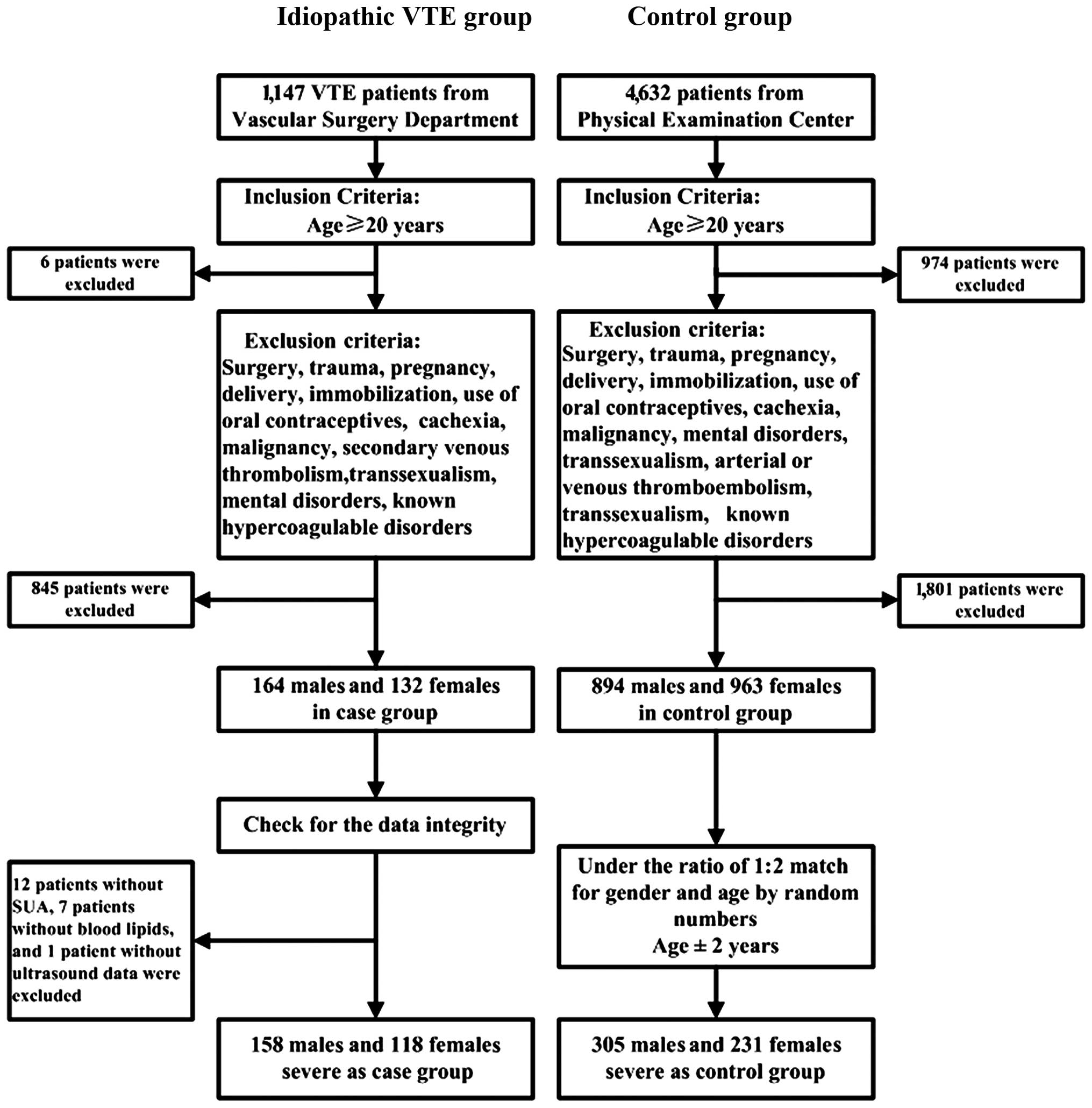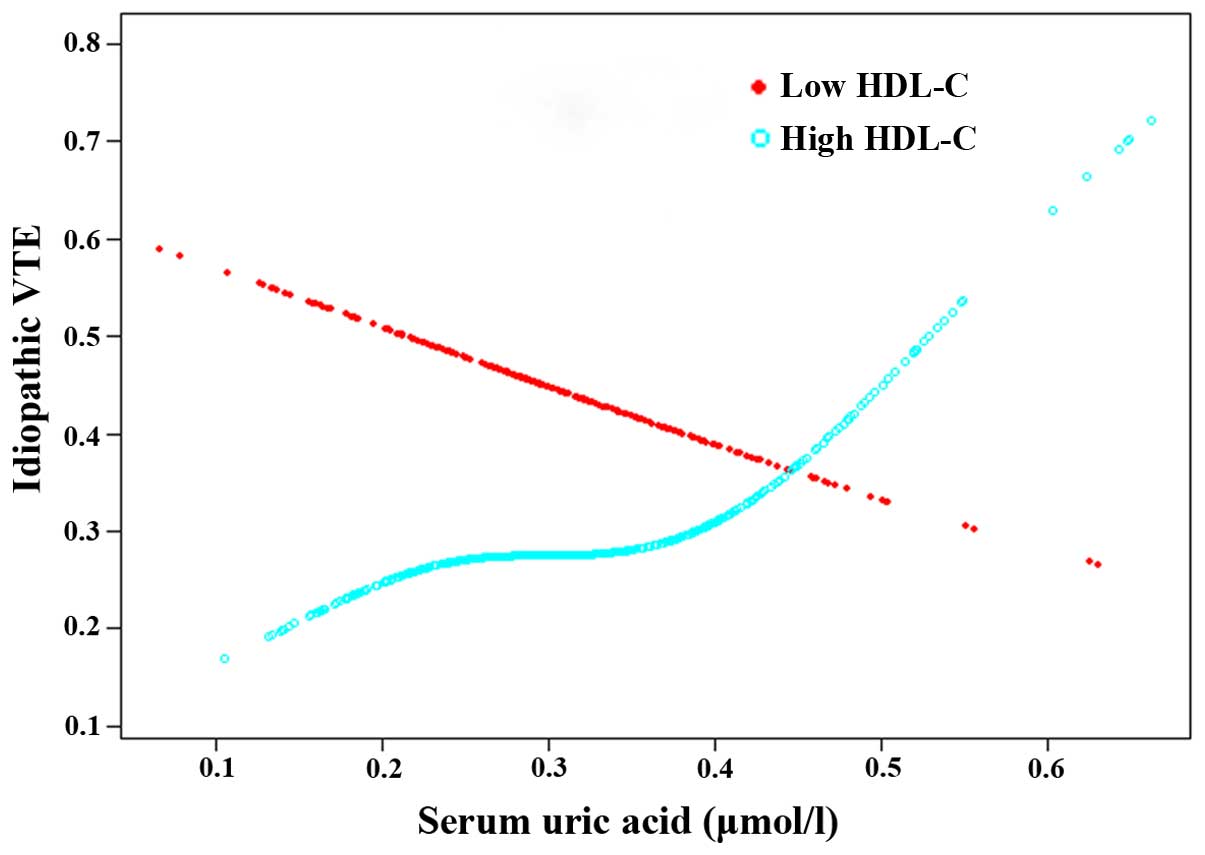|
1
|
Kearon C: Epidemiology of venous
thromboembolism. Semin Vasc Med. 1:7–26. 2001. View Article : Google Scholar : PubMed/NCBI
|
|
2
|
Heit JA: Venous thromboembolism
epidemiology: Implications for prevention and management. Semin
Thromb Hemost. 28(Suppl 2): 3–13. 2002. View Article : Google Scholar : PubMed/NCBI
|
|
3
|
van der Stoep M, Korporaal SJ and Van Eck
M: High-density lipoprotein as a modulator of platelet and
coagulation responses. Cardiovasc Res. 103:362–371. 2014.
View Article : Google Scholar : PubMed/NCBI
|
|
4
|
Brækkan SK, Hald EM, Mathiesen EB,
Njølstad I, Wilsgaard T, Rosendaal FR and Hansen JB: Competing risk
of atherosclerotic risk factors for arterial and venous thrombosis
in a general population: The Tromso study. Arterioscler Thromb Vasc
Biol. 32:487–491. 2012. View Article : Google Scholar : PubMed/NCBI
|
|
5
|
Deguchi H, Pecheniuk NM, Elias DJ, Averell
PM and Griffin JH: High-density lipoprotein deficiency and
dyslipoproteinemia associated with venous thrombosis in men.
Circulation. 112:893–899. 2005. View Article : Google Scholar : PubMed/NCBI
|
|
6
|
Ageno W, Becattini C, Brighton T, Selby R
and Kamphuisen PW: Cardiovascular risk factors and venous
thromboembolism: A meta-analysis. Circulation. 117:93–102. 2008.
View Article : Google Scholar : PubMed/NCBI
|
|
7
|
Glynn RJ, Danielson E, Fonseca FA, Genest
J, Gotto AM Jr, Kastelein JJ, Koenig W, Libby P, Lorenzatti AJ,
MacFadyen JG, et al: A randomized trial of rosuvastatin in the
prevention of venous thromboembolism. N Engl J Med. 360:1851–1861.
2009. View Article : Google Scholar : PubMed/NCBI
|
|
8
|
Steffen LM, Cushman M, Peacock JM,
Heckbert SR, Jacobs DR Jr, Rosamond WD and Folsom AR: Metabolic
syndrome and risk of venous thromboembolism: Longitudinal
investigation of thromboembolism etiology. J Thromb Haemost.
7:746–751. 2009. View Article : Google Scholar : PubMed/NCBI
|
|
9
|
Zhao G, Huang L, Song M and Song Y:
Baseline serum uric acid level as a predictor of cardiovascular
disease related mortality and all-cause mortality: A meta-analysis
of prospective studies. Atherosclerosis. 231:61–68. 2013.
View Article : Google Scholar : PubMed/NCBI
|
|
10
|
Eichinger S, Pecheniuk NM, Hron G, Deguchi
H, Schemper M, Kyrle PA and Griffin JH: High-density lipoprotein
and the risk of recurrent venous thromboembolism. Circulation.
115:1609–1614. 2007. View Article : Google Scholar : PubMed/NCBI
|
|
11
|
Umaerus M, Rosengren B, Fagerberg B,
Hurt-Camejo E and Camejo G: HDL2 interferes with LDL association
with arterial proteoglycans: A possible athero-protective effect.
Atherosclerosis. 225:115–120. 2012. View Article : Google Scholar : PubMed/NCBI
|
|
12
|
Mineo C, Deguchi H, Griffin JH and Shaul
PW: Endothelial and antithrombotic actions of HDL. Circ Res.
98:1352–1364. 2006. View Article : Google Scholar : PubMed/NCBI
|
|
13
|
Asselbergs FW, Williams SM, Hebert PR,
Coffey CS, Hillege HL, Navis G, Vaughan DE, van Gilst WH and Moore
JH: Gender-specific correlations of plasminogen activator
inhibitor-1 and tissue plasminogen activator levels with
cardiovascular disease-related traits. J Thromb Haemost. 5:313–320.
2007. View Article : Google Scholar : PubMed/NCBI
|
|
14
|
Numa S, Hirai T, Nakagawa K, Ohara K,
Fukuda N, Nozawa T and Inoue H: Hyperuricemia and transesophageal
echocardiographic thromboembolic risk in patients with atrial
fibrillation at clinically low-intermediate risk. Circ J.
78:1600–1605. 2014. View Article : Google Scholar : PubMed/NCBI
|
|
15
|
Tang RB, Dong JZ, Yan XL, Du X, Kang JP,
Wu JH, Yu RH, Long DY, Ning M, Sang CH, et al: Serum uric acid and
risk of left atrial thrombus in patients with nonvalvular atrial
fibrillation. Can J Cardiol. 30:1415–1421. 2014. View Article : Google Scholar : PubMed/NCBI
|
|
16
|
Feig DI, Kang DH and Johnson RJ: Uric acid
and cardiovascular risk. N Engl J Med. 359:1811–1821. 2008.
View Article : Google Scholar : PubMed/NCBI
|
|
17
|
Zhang Y, Xu RX, Li S, Zhu CG, Guo YL, Sun
J and Li JJ: Lipoprotein subfractions partly mediate the
association between serum uric acid and coronary artery disease.
Clin Chim Acta. 441:109–114. 2015. View Article : Google Scholar : PubMed/NCBI
|
|
18
|
Martin SS, Jones SR and Toth PP:
High-density lipoprotein subfractions: Current views and clinical
practice applications. Trends Endocrinol Metab. 25:329–336. 2014.
View Article : Google Scholar : PubMed/NCBI
|
|
19
|
Nakagawa T, Hu H, Zharikov S, Tuttle KR,
Short RA, Glushakova O, Ouyang X, Feig DI, Block ER, Herrera-Acosta
J, et al: A causal role for uric acid in fructose-induced metabolic
syndrome. Am J Physiol Renal Physiol. 290:F625–F631. 2006.
View Article : Google Scholar : PubMed/NCBI
|
|
20
|
Zapolski T, Waciński P, Kondracki B,
Rychta E, Buraczyńska MJ and Wysokiński A: Uric acid as a link
between renal dysfunction and both pro-inflammatory and
prothrombotic state in patients with metabolic syndrome and
coronary artery disease. Kardiol Pol. 69:319–326. 2011.PubMed/NCBI
|
|
21
|
Barua RS and Ambrose JA: Mechanisms of
coronary thrombosis in cigarette smoke exposure. Arterioscler
Thromb Vasc Biol. 33:1460–1467. 2013. View Article : Google Scholar : PubMed/NCBI
|
|
22
|
Sweetland S, Parkin L, Balkwill A, Green
J, Reeves G and Beral V: Million Women Study Collaborators:
Smoking, surgery, and venous thromboembolism risk in women: United
Kingdom cohort study. Circulation. 127:1276–1282. 2013. View Article : Google Scholar : PubMed/NCBI
|
|
23
|
Enga KF, Braekkan SK, Hansen-Krone IJ, le
Cessie S, Rosendaal FR and Hansen JB: Cigarette smoking and the
risk of venous thromboembolism: The Tromsø Study. J Thromb Haemost.
10:2068–2074. 2012. View Article : Google Scholar : PubMed/NCBI
|
|
24
|
Blondon M, Wiggins KL, McKnight B, Psaty
BM, Rice KM, Heckbert SR and Smith NL: The association of smoking
with venous thrombosis in women. A population-based, case-control
study. Thromb Haemost. 109:891–896. 2013. View Article : Google Scholar : PubMed/NCBI
|
|
25
|
Blondon M, Wiggins KL, Van Hylckama Vlieg
A, McKnight B, Psaty BM, Rice KM, Heckbert SR and Smith NL:
Smoking, postmenopausal hormone therapy and the risk of venous
thrombosis: A population-based, case-control study. Br J Haematol.
163:418–420. 2013. View Article : Google Scholar : PubMed/NCBI
|
|
26
|
Woodward M, Lowe GD, Rumley A,
Tunstall-Pedoe H, Philippou H, Lane DA and Morrison CE:
Epidemiology of coagulation factors, inhibitors and activation
markers: The Third Glasgow MONICA Survey. II. Relationships to
cardiovascular risk factors and prevalent cardiovascular disease.
Br J Haematol. 97:785–797. 1997. View Article : Google Scholar : PubMed/NCBI
|
|
27
|
Sun GZ, Li Z, Guo L, Zhou Y, Yang HM and
Sun YX: High prevalence of dyslipidemia and associated risk factors
among rural Chinese adults. Lipids Health Dis. 13:1892014.
View Article : Google Scholar : PubMed/NCBI
|
|
28
|
Yang W, Lu J, Weng J, Jia W, Ji L, Xiao J,
Shan Z, Liu J, Tian H, Ji Q, et al: China National Diabetes and
Metabolic Disorders Study Group: Prevalence of diabetes among men
and women in China. N Engl J Med. 362:1090–1101. 2010. View Article : Google Scholar : PubMed/NCBI
|
|
29
|
Gao B, Zhou J, Ge J, Zhang Y, Chen F, Lau
WB, Wan Y, Zhang N, Xing Y, Wang L, et al: Association of maximum
weight with hyperuricemia risk: A retrospective study of 21,414
Chinese people. PLoS One. 7:e511862012. View Article : Google Scholar : PubMed/NCBI
|
















